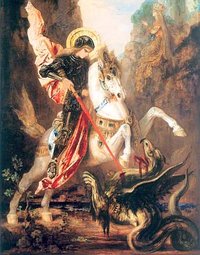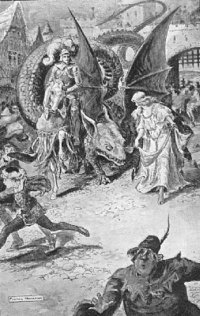Saint George
|
|
For alternate uses, see Saint George (disambiguation)
Saint George (c. 275/280–April 23, 303) was a soldier of the Roman Empire and later Christian martyr.
| Saint George | |
|---|---|
| Martyr | |
| Born | Lydda, Palestine |
| Died | ca. AD 303, Nicomedia, Bithynia |
| Venerated in | Christianity |
| Major shrine | St. George's Church, Lod |
| Feast | April 23 |
| Attributes | Lance, Dragon, Horseback Rider, Knighthood, St George's Cross |
| Patronage | England, Moscow, Lithuania, Lod, Army |
| Contents |
Traditional origin
The traditional account of his life is considered to have originated in the 4th century. According to it, George was born to a Christian family during the late 3rd century. His father was from Cappadocia and served as an officer of the army. His mother was from Lydda, Palestine. She returned to her native city as a widow along with her young son, where she provided her son with a respectable education.
The youth apparently followed his father's example in joining the army soon after his coming of age. Apparently, he proved to be a charismatic soldier and consequently rose quickly through the military ranks of the time. By his late twenties he had gained the titles of tribunus (tribune) and later comes (count), period which George had been positioned in Nicomedia as a member of the personal guard attached to Roman Emperor Diocletian (reign 284–305).
In 303, Diocletian issued an edict authorising the systematic persecution of Christians across the Empire. His caesar Galerius was supposedly responsible for this decision and would continue the persecution during his own reign (305–311). It´s believed that George was ordered to take part in the persecution but instead confessed to being a Christian himself and criticised the imperial decision. An enraged Diocletian proceeded in ordering the torture of this apparent traitor and his execution. According to the tradition, after various other tortures, George was executed by decapitation in front of Nicomedia's defensive wall on April 23, 303. The witness of his suffering convinced Empress Alexandra and an unnamed pagan priest to also become Christians, and so they also joined George in martyrdom as consequence. His body was then returned to Lydda for burial, where Christians soon came to honour George as a martyr.
Veneration as a martyr
The validity of the above account is considered questionable at best. However his veneration as a martyr appears to have started relatively early. A church in his honour was reportedly built in Lydda during the reign of Constantine I (reigned 306–337, sole emperor since 324). The church was destroyed in 1010 but was later rebuilt by the Crusaders. In 1191 and during the conflict known as the Third Crusade (1189–1192), the church was again destroyed by the forces of Saladin, Sultan of the Ayyubid dynasty (reigned 1171–1193). A new church was erected in 1872 and is still standing.
Georgeladoga.jpg
During the 4th century the veneration of George seems to have spread from Palestine to the rest of the Eastern Roman Empire. The 5th century would see his fame reach the Western Roman Empire as well. In 494, George was canonised as a saint by Pope Gelasius I (term 492–496). However Gelasius included George among those "…whose names are justly reverenced among men, but whose acts are known only to God." This statement would not prevent the creation of several differing accounts about his life, several of them filled with miracles. According to the Catholic Encyclopedia, the earliest text preserving fragments of George's highly miraculous narrative is in Acta Sanctorum identified by Fr. Delehaye of the scholarly Bollandists to be a palimpsest of the 5th century, 'full beyond belief of extravagances and of quite incredible marvels'.
This practice would continue for centuries. In the iconography of Eastern Orthodoxy George has been depicted as a soldier since at least the 7th century. Since the 9th century another popular depiction surfaced: George on horseback as the apparent slayer of a European dragon. This depiction was based on a popular legend of Christian mythology with George as its central figure: "George and the Dragon".
The legend of George and the Dragon
It should be noted that the tale found its place in the folk religion of several regions of Europe and Asia Minor so accounts may vary based on local tradition. The tale begins with a dragon making its nest at the spring which provides a city-state with water. Consequently, the citizens had to temporarily remove the dragon from its nest in order to collect water. To do so, they offered the dragon a daily human sacrifice. The victim of the day was chosen by drawing lots. Eventually the "winner" of this lottery happened to be the local princess. The local Monarch is occasionally depicted begging for her life with no result. She is offered to the dragon but at this point a travelling George arrives. He faces the dragon, slays it and saves the princess. The grateful citizens then abandon their ancestral Paganism and convert to Christianity.

The account used to be considered factual but this belief has been progressively abandoned. On the other hand few doubt it contains religious symbolism but various interpretations have been suggested. George can be seen as representing Christianity. In both the Christianized Physiologus and the bestiaries of the 9th through 13th centuries, the dragon is a consistent symbol of Satan. Similarly, in traditional Judaic and early Christian allegory and exegesis, both the serpent (with the vast serpent being a dragon) and leviathan represent Satan. George's victory over the dragon, therefore, has been read allegorically as the victory of Christianity (riding the white horse of the Church Universal) over Satan. Indeed, as late as the 17th century, Edmund Spenser would use the story of George in that manner.
However, secular historians consider the roots of the story to be older than Christianity itself. They note that the origin of the saint is said to be partly from Cappadocia in Asia Minor, and that Asia Minor was among the earliest regions to adopt the popular veneration of the saint. The region had long venerated other religious figures. These historians deem it likely that certain elements of their ancient worship could have passed to their Christian successors. Notable among these ancient deities was Sabazios, the Sky Father of the Phrygians and known as Sabazius to the Romans. This god was traditionally depicted riding on horseback. The iconic image of St. George on horseback trampling the serpent-dragon beneath him is considered to be similar to these pre-Christian representations of Sabazios. So a number of secular historians have suggested that St. George has served as a christianised version of the older deity.
On the other hand, the tale of George and the Dragon is widely considered among secular historians to share a common theme with the ancient Greek myth of Ethiopian princess Andromeda and her saviour and later husband Perseus, slayer of the gorgon Medusa. According to this myth, Perseus beheaded Medusa and George his Dragon in a shared theme of decapitation. Perseus' meeting with Andromeda was placed in her native Ethiopia. In several versions, George meets his Dragon in Libya (North Africa west of Egypt). Both locales can be interpreted to represent distant chthonic kingdoms of magic. The saving of the king's daughter is another shared theme as is the reward-bargain exacted by the respective hero of the stories: Possession of the princess for Perseus and the mass baptism of the king's subjects for George.
Another idea is that Saint George is an alternative manifestation of St Michael, the archangel and captain of the heavenly host.
Saint George's history could be considered an example of Princess and dragon Fairy tales.
Coincidentally, a dragon is an ancient symbol (http://www.24carat.co.uk/welshdragon.html) of Wales, conquered by England (King Edward I).
A comic book, Aliens vs. Predator Annual #1, retold the story with the "dragon" of the legend revealed to be a Yautja, or Predator.
Later depictions and occurrences
In any case, it was through this legend that George would reach his greatest popularity. During the early 2nd millennium and long after his death, George came to be seen as the original "knight in shining armour" (and still on horseback), thus serving as an idealised model of chivalry. And it was also during this time that George would come to be depicted in works of literature, mostly medieval romances.
Coat_of_Arms_of_Moscow.png
Jacobus de Voragine (c. 1230 – July 13, 1298), Archbishop of Genoa authored Legenda Sanctorum (Readings or Legends of the Saints), a collection of legends concerning saints. The book came to be known as Legenda Aurea (Golden Legends) for its worth in the eyes of 13th century readers. Its 177 chapters (182 in other editions) are considered today unreliable as historical sources but significant as literary works. The story of Saint George was prominent among them. This early written account is considered to have influenced later depictions of the saint in Western European literature and art.
King Edward III of England (reigned 1327 – 1377) was known for promoting the codes of knighthood and in 1348 founded the Order of the Garter. During his reign, George came to be recognised as the patron saint of England. On the Iberian peninsula, George also came to be considered as patron to the Crown of Aragon (Aragon, Catalonia, Valencia and Majorca; Catalan: Sant Jordi) and Portugal (Portuguese language: São Jorge) during their struggles against Castile. Their previous patron Saint James the Great was considered more strongly connected to Castile. Already connected in accepting George as their patron saint, in 1386 England and Portugal agreed to an Anglo-Portuguese Alliance. Today this treaty between the United Kingdom and Portugal is still in force.
Saint George is a patron Saint of Georgia. The popular saint would also come to be honored as patron to a number of other countries, cities and causes. The latter vary from archers and Scouts to skin diseases and herpes.
In 1969, Saint George's feast day was reduced to an optional memorial in the Roman Catholic calendar, and the solemnity of his commemoration depends on purely local observance. He is however still honoured as a saint of major importance by Eastern Orthodoxy. His feast date, April 23, is the Day of Aragon (Spain) and is also holiday in Catalonia (Spain) where it is traditional to give a rose and a book to the loved one. This, together with the anniversary of the deaths, in 1616, of Cervantes and Shakespeare has led UNESCO to declare April 23 as World Book and Copyright Day.
St George's Day is also celebrated with parades in those countries of which he is the patron saint.
Colours
The "Colours of Saint George" (more commonly called St George's Cross) is a white flag with a red cross, frequently borne by entities over which he is patron (e.g. England, Georgia, Liguria etc).
See also
- Georgslied a 9th-century Old High German poem about the life of Saint George.
- Knights of St. George
External links
- Saint George and the Dragon links (http://www.isidore-of-seville.com/dragons/6.html) and pictures (http://www.isidore-of-seville.com/dragons/38.html) (more than 125), from Dragons in Art and on the Web (http://www.isidore-of-seville.com/dragons/)
- Catholic hagiography (http://www.catholic-forum.com/saints/saintg05.htm)
- Saint George and the Boy Scouts (http://www.pinetreeweb.com/stgeorge.htm), including a woodcut of a Scout on horseback slaying a dragon
- prayer for St George's Day (http://www.digitas.harvard.edu/cgi-bin/wiki/ken/SaintGeorgeAa)
- St. George (http://www.niranamchurch.com/StGeorge.asp)bg:Георги Победоносец
ca:Sant Jordi de:Georg (Heiliger) et:Püha Jüri es:San Jorge eo:Sankta Georgo fr:Saint Georges it:San Giorgio nl:Joris (heilige) ja:ゲオルギウス pl:Święty Jerzy pt:São Jorge (santo) fi:Pyhä Yrjänä simple:Saint George sv:Sankt Göran zh:圣乔治


